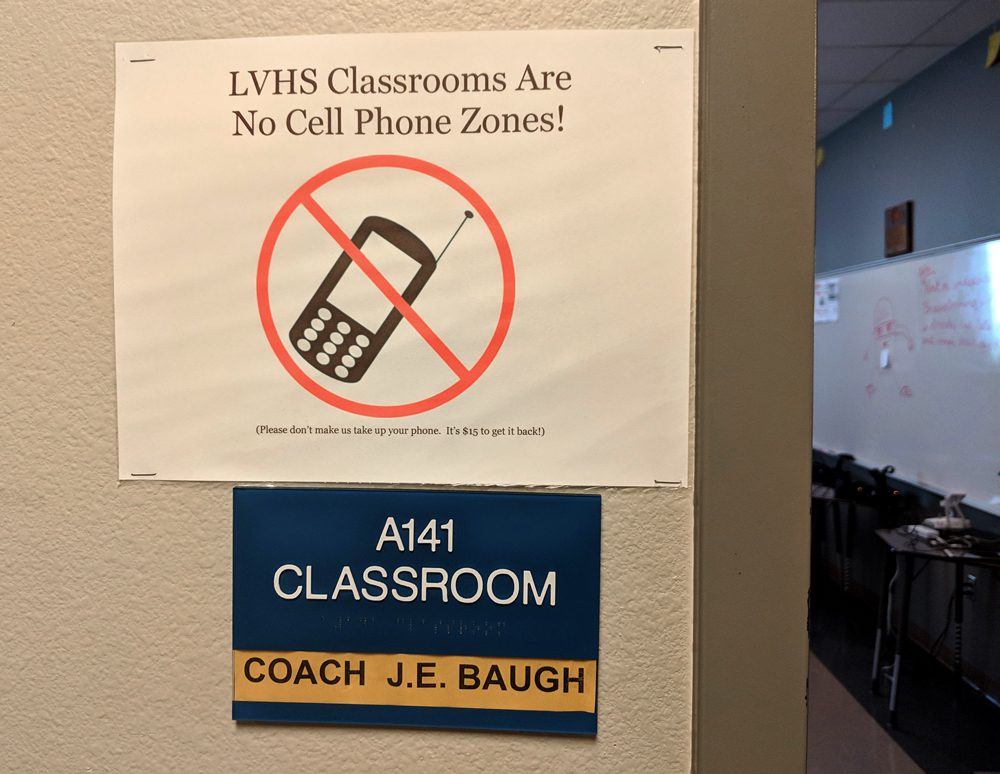
By Sean McCormick
Jim Ed Baugh, who teaches the Lago Vista High School audiovisual program, recently noticed one of his students taking a picture of his math homework with an app on his smartphone. The app then solved the math problem, based on the image.
At Lago Vista High School, despite the no-cell phone flyers posted outside the classrooms, teachers are allowed to make the call whether to incorporate smartphones into their curriculums, which has created some challenges.
Lago Vista’s first school was a single-teacher, one-room affair, established in 1895. If there was a student handbook back then, it was probably nothing like the 144-page document that currently exists. According to the 2018-19 Lago Vista ISD Student Handbook, “In some cases, students may find it beneficial or might be encouraged to use personal telecommunications or other personal electronic devices for instructional purposes while on campus.” Students must obtain prior approval and sign a user agreement in order to bring a smartphone to school.
Some students struggle with self-control during class. Communications teacher Steve Garcia once caught a student watching the television show Grey’s Anatomy during his lecture. If a student appears to be having difficulty paying attention, the device is taken from them. If it ends up in the office, it costs $15 to get it back.
It’s not just television shows that are diverting attention. Social media can also be a distraction for young people throughout the day. According to computer science teacher Rebecca Holt, Snapchat and Instagram are the two most popular social media applications at the high school. Holt recalls asking some of the girls in her class, “How many pictures can you take of yourselves?”
Smartphone use has also made it into the 504 plans which accommodate students with special needs. Garcia has one student who is allowed to play video games on his smartphone as part of his 504 plan. This required Garcia to explain the situation to the rest of the students, so they aren’t resentful or confused. “We talk a lot about the fact that equal is not always just,” he said.
Regarding whether smartphones in the classroom are affecting student performance, Baugh is unsure. “It’s hard to tell if devices are having an effect on test scores because it’s too difficult to establish a control group,” he said. According to technology teacher Heather Womack, student’s personal device ownership is over 90%. In 2018, Professor Arnold Glass and graduate student Mengxue Kang conducted a study with students at Rutgers University that utilized control groups. They concluded that test scoring and the ability to recall information was higher without devices present.

Figure 1: Arnold L. Glass & Mengxue Kang (2018): Dividing attention in the classroom
History teacher Scottie Johnson feels students need to learn self-control while they are still in grade school. “Before the web, there were kids who weren’t paying attention: they were writing notes, they were doodling, they were staring at a wall. I don’t think devices turn good students into bad students. The kid who is off-task is going to be off-task, no matter what. I liken it to, as an adult, you have to learn how to sit next to cake. If everything’s locked down in high school, when they get to college it’s novel and potentially costly,” she said. Glass disagrees. “It is obvious to anyone who has stood in front of a class that watching a video on a cell phone is qualitatively different than doodling or staring at a wall because it is much more interesting and absorbs much more of the student’s attention,” he said.
The school district has been pressured by parents to allow phones into the classroom. There are working and single parents who want to be able to relay scheduling issues, even though the students have access to email via their school-assigned iPads. According to Garcia, Womack, Baugh and Holt, some parents are abusing this communication convenience. Parents will call and text during classes about non-essential issues, putting the students in a bind, and they then request permission to either answer a text or take a call in the hallway. According to recent Lago Vista High graduate Zoe Schneider, “A lot of parents think they’re above the school system. My parents would text me during the day, but I would only respond between classes.”
These issues aside, most faculty at the high school feel a ban on smartphones would be impractical. Baugh doesn’t feel eliminating the devices is the answer. “Just like prohibition with alcohol, kids are going to find a way around it. It’s just denying the inevitable. Before, teachers would be like, ‘You’re never going to have a calculator on you all the time.’ Well, now you do. Better to get out in front of it and try to control it, use it purposefully. Let them (the students) use it as a source of information,” he said.
The State of Texas Assessments of Academic Readiness or STAAR Test now allows students to listen to music without lyrics using earbuds or headphones as a focusing device while test-taking.
Lago Vista High School Principal Heather Stoner is optimistic. “I don’t see the difference today being as much about the technology as it is about collaboration. Coming to consensus, working together and communicating. All those soft skills are just as important as the academics. I think today’s kids are awesome. I think about who I taught 20 years ago, these kids are just better problem-solvers and thinkers — just great to be around. The kids now are interactive,” she said.